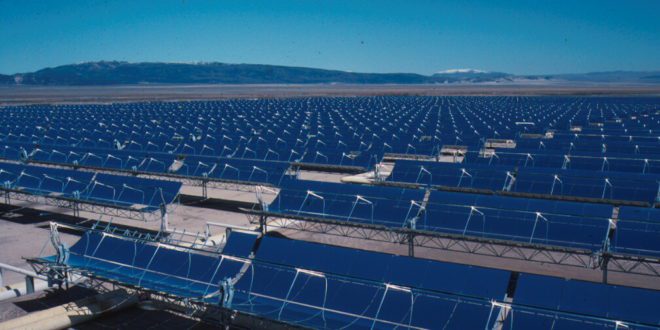RENEWABLES GROW 16.3% IN FIRST HALF 2017 AS NUCLEAR POWER FALLS 3.3%
SOLAR BALLOONS BY 45.1%; NOW OUTPACING BIOMASS, GEOTHERMAL, AND OIL
 Washington DC – The latest issue of the U.S. Energy Information’s (EIA) “Electric Power Monthly” (with data through June 30, 2017) reveals that renewable energy sources (i.e., biomass, geothermal, hydropower, solar – inc. small-scale PV, and wind) remain in a statistical dead heat with nuclear power vis-à-vis their respective shares of the nation’s electrical generation, with each providing roughly 20% of the total. [1]
Washington DC – The latest issue of the U.S. Energy Information’s (EIA) “Electric Power Monthly” (with data through June 30, 2017) reveals that renewable energy sources (i.e., biomass, geothermal, hydropower, solar – inc. small-scale PV, and wind) remain in a statistical dead heat with nuclear power vis-à-vis their respective shares of the nation’s electrical generation, with each providing roughly 20% of the total. [1]During the six-month period (January – June), renewables surpassed nuclear power in three of those months (March, April, and May) while nuclear power took the lead in the other three. In total, according to EIA’s data, utility-scale renewables plus small-scale solar PV provided 20.05% of U.S. net electrical generation compared to 20.07% for nuclear power. However, renewables may actually hold a small lead because while EIA estimates the contribution from distributed PV, it does not include electrical generation by distributed wind, micro-hydro, or small-scale biomass.
EIA has acknowledged the neck-in-neck status of nuclear power and renewables and stated as much in a news release it issued in early summer. However, the agency simultaneously stressed its view that “nuclear will generate more electricity than renewables for all of 2017.” [2]
Well, maybe …. maybe not.
While renewables and nuclear are each likely to continue to provide roughly one-fifth of the nation’s electricity generation in the near-term, the trend line clearly favors a rapidly expanding market share by renewables compared to a stagnating, if not declining, one for nuclear power. Electrical output by renewables during the first half of 2017 was 16.34% higher than for the same period in 2016 whereas nuclear output dropped by 3.27%. In the month of June alone, electrical generation by renewable sources was 27.15% greater than a year earlier whereas nuclear output dipped by 0.24%.
In fact, almost all renewable energy sources are experiencing strong growth rates. Comparing the first six months of 2017 to the same period in 2016, utility-scale + small-scale solar has grown by 45.1%, hydropower by 16.1%, wind by 15.6%, and geothermal by 3.2%. Biomass (inc. wood and wood-derived fuels) has remained essentially unchanged – slipping by 0.8%. Electrical generation by solar alone is now greater than that provided individually by biomass, geothermal, and oil (i.e., petroleum liquids + petroleum coke).
And on the capacity front, renewables long ago eclipsed nuclear power. For the first half of 2017, the Federal Energy Regulatory Commissions recently reported that renewables’ share of total U.S. available installed generating capacity is 19.70% compared to 8.98% for nuclear — i.e., more than double. [3]
Finally, last month’s cancellation of the Summer 2 and 3 reactors in South Carolina and Duke Power’s subsequent decision to pull the plug on construction of the twin William Lee reactors (also in South Carolina) means the growing gap between renewables and nuclear will accelerate at an even faster clip in the coming years. In addition, the possible cancellation of the uneconomic Vogtle 3 and 4 reactors in Georgia would mean no new nuclear coming online for the foreseeable future, as reactor closures continue. In fact, counting possible additional closures and cancellations, retirements could very likely exceed additions. [4]
“Everyone loves a horse race,” noted Ken Bossong, Executive Director of the SUN DAY Campaign. “However, the smart money is now on renewables to soon leave nuclear power in the dust.”
“Nuclear power is in irreversible decline in the U.S., due to rising costs and failing economics of new and existing reactors, alike,” said Tim Judson, executive director of the Nuclear Information and Resource Service. “Last month’s cancellation of half the new reactors under construction in the U.S. means that gap is going to be wider than projected, and accelerating.”
“Nuclear power is in irreversible decline in the U.S., due to rising costs and failing economics of new and existing reactors, alike,” said Tim Judson, executive director of the Nuclear Information and Resource Service. “Last month’s cancellation of half the new reactors under construction in the U.S. means that gap is going to be wider than projected, and accelerating.”
 Alternative Energy HQ solar power for homes, wind energy, and bio fuel issues
Alternative Energy HQ solar power for homes, wind energy, and bio fuel issues







